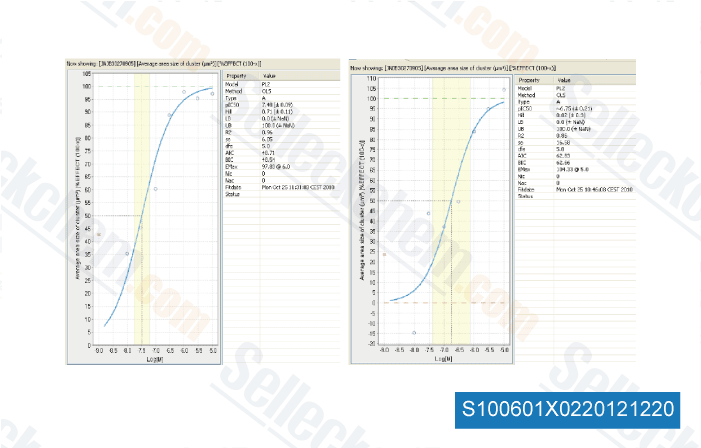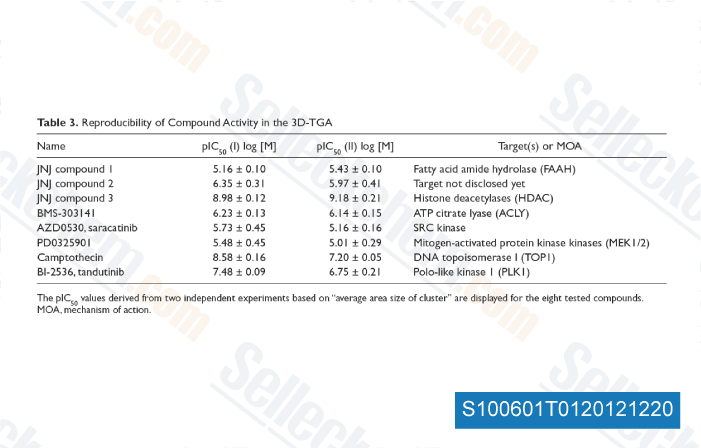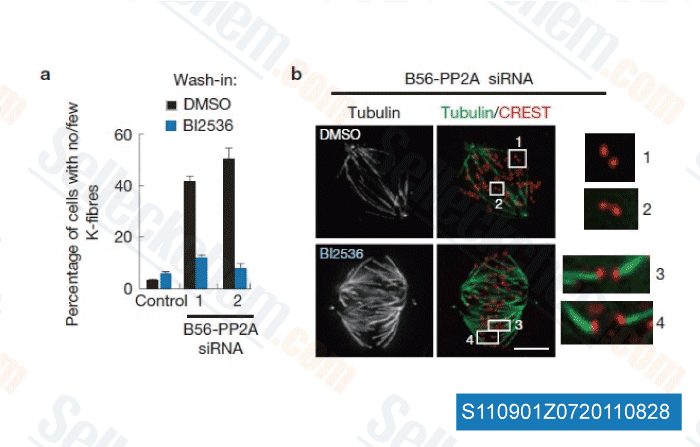|
Toll Free: (877) 796-6397 -- USA and Canada only -- |
Fax: +1-832-582-8590 Orders: +1-832-582-8158 |
Tech Support: +1-832-582-8158 Ext:3 Please provide your Order Number in the email. |
Technical Data
| Formula | C28H39N7O3 |
||||||||||
| Molecular Weight | 521.66 | CAS No. | 755038-02-9 | ||||||||
| Solubility (25°C)* | In vitro | DMSO | 100 mg/mL (191.69 mM) | ||||||||
| Ethanol | 50 mg/mL (95.84 mM) | ||||||||||
| Water | Insoluble | ||||||||||
| In vivo (Add solvents to the product individually and in order) |
|
||||||||||
|
* <1 mg/ml means slightly soluble or insoluble. * Please note that Selleck tests the solubility of all compounds in-house, and the actual solubility may differ slightly from published values. This is normal and is due to slight batch-to-batch variations. * Room temperature shipping (Stability testing shows this product can be shipped without any cooling measures.) |
|||||||||||
Preparing Stock Solutions
Biological Activity
| Description | BI-2536 is a potent Plk1 inhibitor with IC50 of 0.83 nM in a cell-free assay. BI-2536 inhibits Bromodomain 4 (BRD4) with Kd of 37 nM and potently suppresses c-Myc expression. BI-2536 induces apoptosis and attenuates autophagy. Phase 2. | ||||||||||
|---|---|---|---|---|---|---|---|---|---|---|---|
| Targets |
|
||||||||||
| In vitro | BI 2536 blocks the activities of Plk2 and Plk3 to a slightly lesser extent with IC50 of 3.5 nM and 9.0 nM, respectively. In HeLa cells, BI 2536 treatment ranging from 10-100 nM leads to the blocking of the recruitment of γ-tubulin and phosphorylation of Apc6 at mitotic centrosomes, inhibition of cohesin release from chromosome arms, induction of monopolar spindles, as well as a range of other mitotic processes that are known to depend on Plk1. BI 2536 treatment leads to the HeLa cells arrested in G2/M, subsequently a sub-G1 DNA peak indicative of DNA breakdown and apoptosis, and accumulated cleaved PARP p85 fragments in a concentration-dependent manner. BI 2536 inhibits the growth of a panel of 32 human cancer cell lines with EC50 of 2-25 nM, while blocking the proliferation of exponentially growing hTERT-RPE1, human umbilical vein endothelial cells (HUVECs), and normal rat kidney (NRK) cells with EC50 of 12-31 nM. [1] Plk1 inhibition by BI 2536 reduces the growth and viability of anaplastic thyroid carcinoma (ATC) cells such as CAL62, OCUT-1, SW1736, 8505C, and ACT-1 with EC50 values of 1.4-5.6 nM. [2] |
||||||||||
| In vivo | BI 2536 given i.v. once or twice per week is highly efficacious in diverse xenograft models with acceptable tolerability by inhibiting cell proliferation through a mitotic arrest, and subsequently induction of tumor-cell death. Administration of BI 2536 at 50 mg/kg once or twice per week significantly inhibits growth of HCT 116 xenografts with T/C of 15% and 0.3%, respectively. BI 2536 treatment twice-weekly also leads to excellent tumor-growth in BxPC-3 and A549 models with T/C of 5% and 14%, respectively. [1] |
||||||||||
| Features | The first potent and selective Plk1 inhibitor that induces all hallmarks of Plk1 inhibition. |
Protocol (from reference)
| Kinase Assay: |
|
|---|---|
| Cell Assay: |
|
| Animal Study: |
|
References
|
Customer Product Validation

-
Data from [J Biomol Screen, 2013, 18(1), 54-66]

-
Data from [J Biomol Screen, 2013, 18(1), 54-66]

-
Data from [J Biol Chem, 2012, 287(21), 17088-99]

-
Data from [Nat Cell Biol, 2011, 13, 1265-71]
Selleck's BI 2536 has been cited by 306 publications
| Spatio-temporal control of mitosis using light via a Plk1 inhibitor caged for activity and cellular permeability [ Nat Commun, 2025, 16(1):1599] | PubMed: 39971898 |
| Revisiting phosphoregulation of Cdc25C during M-phase induction [ iScience, 2025, 28(1):111603] | PubMed: 39834856 |
| Novel BRCA1-PLK1-CIP2A axis orchestrates homologous recombination-mediated DNA repair to maintain chromosome integrity during oocyte meiosis [ Nucleic Acids Res, 2024, gkae1207] | PubMed: 39657788 |
| The Eμ-Ret mouse is a novel model of hyperdiploid B-cell acute lymphoblastic leukemia [ Leukemia, 2024, 38(5):969-980] | PubMed: 38519798 |
| Therapeutic targeting of PLK1 in TERT promoter-mutant hepatocellular carcinoma [ Clin Transl Med, 2024, 14(5):e1703] | PubMed: 38769666 |
| Therapeutic targeting of PLK1 in TERT promoter-mutant hepatocellular carcinoma [ Clin Transl Med, 2024, 14(5):e1703] | PubMed: 38769666 |
| Dynamic phosphorylation of FOXA1 by Aurora B guides post-mitotic gene reactivation [ Cell Rep, 2024, 43(9):114739] | PubMed: 39276350 |
| Proteomic analysis reveals a PLK1-dependent G2/M degradation program and a role for AKAP2 in coordinating the mitotic cytoskeleton [ Cell Rep, 2024, 43(8):114510] | PubMed: 39018246 |
| Polθ is phosphorylated by PLK1 to repair double-strand breaks in mitosis [ Nature, 2023, 621(7978):415-422] | PubMed: 37674080 |
| Polθ is phosphorylated by PLK1 to repair double-strand breaks in mitosis [ Nature, 2023, 621(7978):415-422] | PubMed: 37674080 |
RETURN POLICY
Selleck Chemical’s Unconditional Return Policy ensures a smooth online shopping experience for our customers. If you are in any way unsatisfied with your purchase, you may return any item(s) within 7 days of receiving it. In the event of product quality issues, either protocol related or product related problems, you may return any item(s) within 365 days from the original purchase date. Please follow the instructions below when returning products.
SHIPPING AND STORAGE
Selleck products are transported at room temperature. If you receive the product at room temperature, please rest assured, the Selleck Quality Inspection Department has conducted experiments to verify that the normal temperature placement of one month will not affect the biological activity of powder products. After collecting, please store the product according to the requirements described in the datasheet. Most Selleck products are stable under the recommended conditions.
NOT FOR HUMAN, VETERINARY DIAGNOSTIC OR THERAPEUTIC USE.
